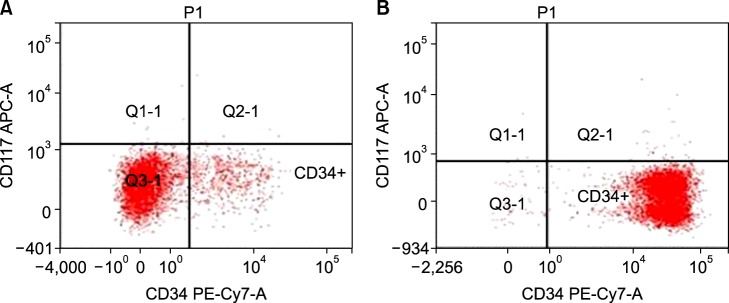Blood Res.
2014 Dec;49(4):241-245. 10.5045/br.2014.49.4.241.
Aberrant myeloid antigen co-expression is correlated with high percentages of CD34-positive cells among blasts of acute lymphoblastic leukemia patients: an Indian tertiary care center perspective
- Affiliations
-
- 1Department of Hematology, All India Institute of Medical Sciences, New Delhi, India. renusaxena@outlook.com
- KMID: 2270681
- DOI: http://doi.org/10.5045/br.2014.49.4.241
Abstract
- BACKGROUND
Aberrant myeloid antigen (MA) co-expression and high expression of CD34 antigen on the blasts of acute lymphoblastic leukemia (ALL) patients are independently reported to have a role in pathogenesis and prognosis. This study was conducted to determine whether these two parameters are related.
METHODS
A total of 204 cases of ALL were included in an analysis of blast immunophenotypic data. CD34 expression was categorized as low when less than 50% of blasts were CD34-positive (CD34low) and as high when 50% or more were CD34-positive (CD34high).
RESULTS
Of 204 cases of ALL, 163 and 41 were of B-cell origin (B-ALL) and T-cell origin (T-ALL), respectively. Of all cases, 132 (64.7%) showed co-expression of MA and among these, 101 (76.51%) were CD34high, while the remaining 31 (23.48%) were CD34low. Of 72 cases without MA co-expression, 25 (34.72%) were CD34high and 47 (67.25%) were CD34low. Furthermore, of 163 cases of B-ALL, 111 showed co-expression of MA and 84 of these were CD34high. Of 52 cases of B-ALL without MA expression, 22 were CD34high. Among 41 cases of T-ALL, 21 co-expressed MA, 17 of which were CD34high. Moreover, all 20 cases of T-ALL without co-expression of MA were CD34low. These differences were statistically significant.
CONCLUSION
We observed a strong correlation between aberrant MA expression and CD34high expression on the blasts of ALL. We hypothesize that these different patient subsets may represent unique prognostic characteristics.
Keyword
MeSH Terms
Figure
Reference
-
1. Tijchon E, Havinga J, van Leeuwen FN, Scheijen B. B-lineage transcription factors and cooperating gene lesions required for leukemia development. Leukemia. 2013; 27:541–552. PMID: 23047478.
Article2. Drexler HG, Thiel E, Ludwig WD. Review of the incidence and clinical relevance of myeloid antigen-positive acute lymphoblastic leukemia. Leukemia. 1991; 5:637–645. PMID: 1886419.3. Shen HQ, Tang YM, Yang SL, et al. Immunophenotyping of 222 children with acute leukemia by multi-color flow cytometry. Zhonghua Er Ke Za Zhi. 2003; 41:334–337. PMID: 14751050.4. Vitale A, Guarini A, Ariola C, et al. Absence of prognostic impact of CD13 and/or CD33 antigen expression in adult acute lymphoblastic leukemia. Results of the GIMEMA ALL 0496 trial. Haematologica. 2007; 92:342–348. PMID: 17339183.
Article5. Sobol RE, Mick R, Royston I, et al. Clinical importance of myeloid antigen expression in adult acute lymphoblastic leukemia. N Engl J Med. 1987; 316:1111–1117. PMID: 3494942.
Article6. Uckun FM, Sather HN, Gaynon PS, et al. Clinical features and treatment outcome of children with myeloid antigen positive acute lymphoblastic leukemia: a report from the Children's Cancer Group. Blood. 1997; 90:28–35. PMID: 9207434.7. Katz FE, Tindle R, Sutherland DR, Greaves MF. Identification of a membrane glycoprotein associated with haemopoietic progenitor cells. Leuk Res. 1985; 9:191–198. PMID: 3857408.
Article8. van Stijn A, van der Pol MA, Kok A, et al. Differences between the CD34+ and CD34- blast compartments in apoptosis resistance in acute myeloid leukemia. Haematologica. 2003; 88:497–508. PMID: 12745269.9. Oyan AM, Bo TH, Jonassen I, et al. CD34 expression in native human acute myelogenous leukemia blasts: differences in CD34 membrane molecule expression are associated with different gene expression profiles. Cytometry B Clin Cytom. 2005; 64:18–27. PMID: 15668952.10. Borowitz MJ, Shuster JJ, Civin CI, et al. Prognostic significance of CD34 expression in childhood B-precursor acute lymphocytic leukemia: a Pediatric Oncology Group study. J Clin Oncol. 1990; 8:1389–1398. PMID: 1696310.
Article11. Terstappen LW, Safford M, Konemann S, et al. Flow cytometric characterization of acute myeloid leukemia. Part II. Phenotypic heterogeneity at diagnosis. Leukemia. 1992; 6:70–80. PMID: 1540262.12. Jennings CD, Foon KA. Recent advances in flow cytometry: application to the diagnosis of hematologic malignancy. Blood. 1997; 90:2863–2892. PMID: 9376567.
Article13. Pui CH, Behm FG, Crist WM. Clinical and biologic relevance of immunologic marker studies in childhood acute lymphoblastic leukemia. Blood. 1993; 82:343–362. PMID: 8329694.
Article14. Pui CH, Raimondi SC, Hancock ML, et al. Immunologic, cytogenetic, and clinical characterization of childhood acute lymphoblastic leukemia with the t(1;19) (q23; p13) or its derivative. J Clin Oncol. 1994; 12:2601–2606. PMID: 7989935.
Article15. Borkhardt A, Cazzaniga G, Viehmann S, et al. Associazione Italiana Ematologia Oncologia Pediatrica and the Berlin-Frankfurt-Munster Study Group. Incidence and clinical relevance of TEL/AML1 fusion genes in children with acute lymphoblastic leukemia enrolled in the German and Italian multicenter therapy trials. Blood. 1997; 90:571–577. PMID: 9226156.
Article16. De Zen L, Orfao A, Cazzaniga G, et al. Quantitative multiparametric immunophenotyping in acute lymphoblastic leukemia: correlation with specific genotype. I. ETV6/AML1 ALLs identification. Leukemia. 2000; 14:1225–1231. PMID: 10914546.
Article17. Pui CH, Frankel LS, Carroll AJ, et al. Clinical characteristics and treatment outcome of childhood acute lymphoblastic leukemia with the t(4;11)(q21;q23): a collaborative study of 40 cases. Blood. 1991; 77:440–447. PMID: 1991161.18. Pui CH, Hancock ML, Head DR, et al. Clinical significance of CD34 expression in childhood acute lymphoblastic leukemia. Blood. 1993; 82:889–894. PMID: 7687897.
Article19. Vanhaeke DR, Bene MC, Garand R, Faure GC. Expression and long-term prognostic value of CD34 in childhood and adult acute lymphoblastic leukemia. Leuk Lymphoma. 1995; 20:137–142. PMID: 8750635.
Article20. Thomas X, Archimbaud E, Charrin C, Magaud JP, Fiere D. CD34 expression is associated with major adverse prognostic factors in adult acute lymphoblastic leukemia. Leukemia. 1995; 9:249–253. PMID: 7532767.
- Full Text Links
- Actions
-
Cited
- CITED
-
- Close
- Share
- Similar articles
-
- Biological Characteristics of AC133 Antigen-Positive Acute Leukemia
- Clinical Significance of CD34 Antigen Positivity in Childhood Acute Lymphoblastic Leukemia
- The Role of CD34 in the Immunophenotyping Panel of Leukemia
- A Case of Chronic Myelogenous Leukemia with Abnormal Expression of N-CAM (CD56) Adhesion Molecule on CD34-negative Non-blastic Myeloid Cells
- CD34 immunohistochemical staining of bone marrow biopsies in myelodysplastic syndromes



